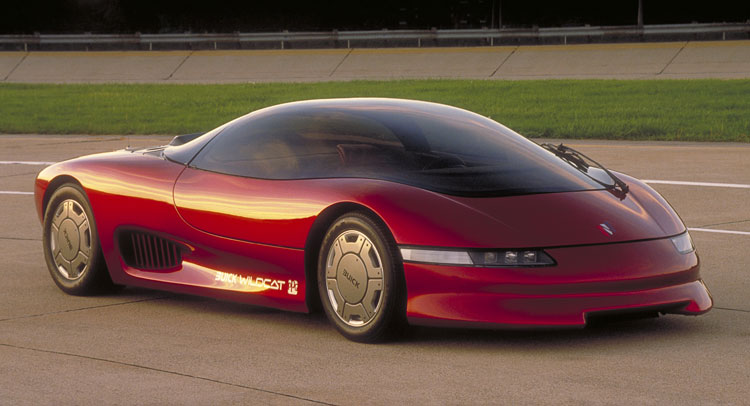Buick’s recent unveiling of the Avenir study at the Detroit Auto Show served as a good excuse for the automaker to look back at its most influential studies. As the manufacturer of the world’s first concept car, the 1938 Y-Job, Buick has a strong legacy in this field.
Since 1938, Buick concept cars have explored new styling and technological features and played an important role in developing new production models. “From designs that push the boundaries of graceful, elegant proportions and progressive interior designs, Buick’s concepts have always inspired with the relevance of a future that is not too far away,” said Ed Welburn, vice president of General Motors Global Design.
Without further ado, here are five of the most influential concepts that helped Buick move forward in areas like design, driver technology or powertrain technology.
1. Y-Job (1938)
 Widely regarded as the industry’s first true concept car, the Y-Job was developed by GM’s first design chief, Harley Earl. Much like many of today’s concept cars, its purpose was to gauge the public’s response to the innovative styling and features rather than previewing a new production model.
Widely regarded as the industry’s first true concept car, the Y-Job was developed by GM’s first design chief, Harley Earl. Much like many of today’s concept cars, its purpose was to gauge the public’s response to the innovative styling and features rather than previewing a new production model.
Still, the Y-Job previewed features that would later make it to production, including power windows, flush-mounted door handles, disappearing headlamps and a concealed convertible top. All these never-before-seen features led the media to describe it as the “Car of the Future.”
2. Wildcat Series (1953-55, 1985)
 Buick’s Wildcat series of concept vehicles featured futuristic design as well as new and innovative technologies. The first Wildcat concept from 1953 was a two-seater with a fiberglass body and four-wheel disc brakes.
Buick’s Wildcat series of concept vehicles featured futuristic design as well as new and innovative technologies. The first Wildcat concept from 1953 was a two-seater with a fiberglass body and four-wheel disc brakes.
It was followed in 1954 by the Wildcat II, a smaller, sportier two-seater that introduced a more radical design with open front fenders. The 1955 Wildcat III showcased elongated front fender openings and the brand’s signature sweep-spear cue. Interestingly, Buick says the grille design of these early concepts influenced the all-new Avenir concept.
 In 1985, Buick introduced the futuristic Wildcat concept that served as a test and data platform. The study had no traditional doors, but a canopy that raised and lowered to allow access for two passengers.
In 1985, Buick introduced the futuristic Wildcat concept that served as a test and data platform. The study had no traditional doors, but a canopy that raised and lowered to allow access for two passengers.
Distinctly styled with a long rear deck, the body was made of fiberglass and carbon fiber. Power came from a unique engine based on Buick’s 3.8-liter V6 that featured 24 valves, dual-overhead camshafts and an early version of electronically controlled port fuel injection. The engine was mounted behind the cabin and drove all four wheels. The 1985 Wildcat also featured a head-up display, a feature available on today’s LaCrosse.
3. Riviera Silver Arrow III (1972)
 The Silver Arrow III study was based on the third-generation Riviera production model, but featured bolder design elements as well as advanced technologies such as four-wheel antilock brakes and a Max Trac traction control system – a precursor of today’s traction control technology.
The Silver Arrow III study was based on the third-generation Riviera production model, but featured bolder design elements as well as advanced technologies such as four-wheel antilock brakes and a Max Trac traction control system – a precursor of today’s traction control technology.
Designed by Bill Mitchell, the car had a lowered roofline, restyled quarter windows and six halogen headlamps. Inside, the Silver Arrow III had adjustable pedals and a telescoping steering wheel.
4. Centieme (2003)
 The Centieme (French for “one-hundredth”) marked Buick’s 100th anniversary while also offering a vision of its future. You’ll probably recognize the Enclave crossover in the study’s proportions, design cues and three-row seating configuration. The Centieme also featured elements such as aluminum and wood accent trim and ambient lighting.
The Centieme (French for “one-hundredth”) marked Buick’s 100th anniversary while also offering a vision of its future. You’ll probably recognize the Enclave crossover in the study’s proportions, design cues and three-row seating configuration. The Centieme also featured elements such as aluminum and wood accent trim and ambient lighting.
5. Velite (2004)
 Designed in Warren, Michigan, and built by renowned coachbuilder Bertone in Italy, this four-seat convertible study was named after an elite class of soldiers in Napoleon’s army. While design cues like the portholes on the front fenders and the rear deck contoured in a boat tail shape reminded of Buicks of the past, there was nothing retro about the engine, a 400hp 3.6-liter twin-turbocharged V6 driving the rear wheels.
Designed in Warren, Michigan, and built by renowned coachbuilder Bertone in Italy, this four-seat convertible study was named after an elite class of soldiers in Napoleon’s army. While design cues like the portholes on the front fenders and the rear deck contoured in a boat tail shape reminded of Buicks of the past, there was nothing retro about the engine, a 400hp 3.6-liter twin-turbocharged V6 driving the rear wheels.



